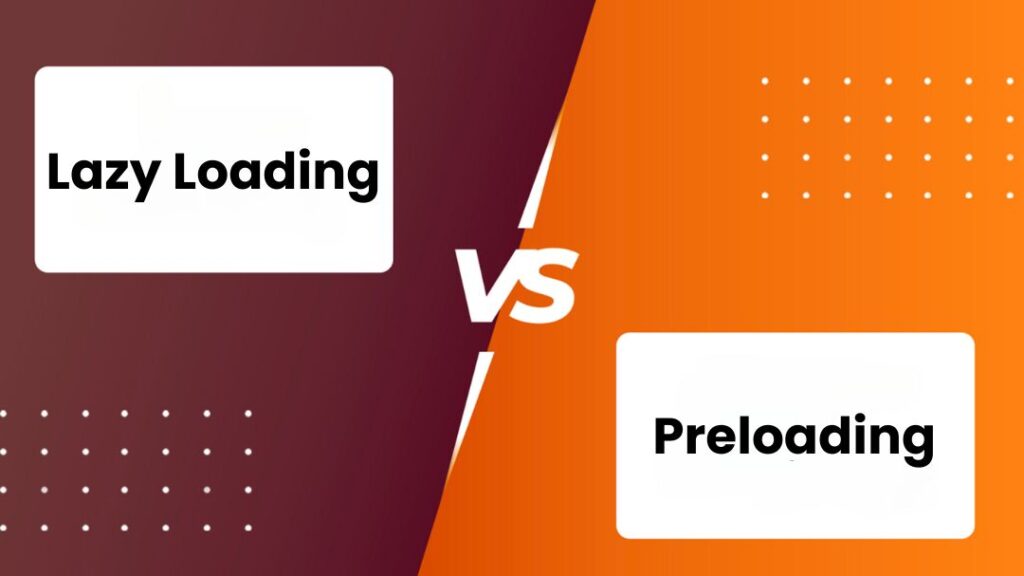In today’s web development world, images play a huge role in making websites look great and keeping users engaged. But loading those images the right way can make or break a site’s performance. Two common methods stand out: lazy loading and preloading. Both have their strengths and weaknesses, and picking the right one depends on what your website needs. In this blog post, we’ll break down what lazy loading and preloading are, look at their pros and cons, and figure out which one might be the better choice in 2025. Let’s get started.
What Are Lazy Loading and Preloading?
Before we jump into the details, let’s define these two techniques in simple terms.
Lazy Loading Explained
Lazy loading is a method where images only load when they’re about to show up on the user’s screen. Imagine scrolling through a long webpage—pictures don’t load until you get close to them. This cuts down on the data a page uses right away, speeding up the time it takes for the site to become usable.
This technique is great for saving bandwidth and making pages load faster at first. It’s been around for a while, and now browsers like Chrome and Firefox even support it natively with a simple HTML tag. No fancy coding required!
Preloading Explained
Preloading is the opposite approach. It loads images before the user needs them. Think of a photo gallery where the next few pictures are ready to go before you click “next.” This makes sure there’s no waiting when you want to see the images, giving you a smooth experience.
Preloading uses tools like HTML tags or scripts to fetch images early. It’s all about being ready ahead of time, even if it means using more data upfront.
Also, Discover The Top 5 AI-Powered Tools for Website Speed Optimization.
Pros and Cons of Lazy Loading
Now that we know what lazy loading is, let’s weigh its benefits and downsides.
Benefits of Lazy Loading
-
Faster First Load: Since images wait to load until they’re needed, the page gets up and running quicker. Users don’t have to wait for every picture to download before they can start browsing.
-
Less Data Used: Lazy loading only grabs images you’re about to see. If you never scroll to the bottom of a page, those bottom images don’t load. This saves data, which is awesome for people with limited internet plans.
-
Helps Slow Connections: For users on spotty or slow networks, lazy loading keeps the focus on the main content instead of bogging things down with tons of images.
Downsides of Lazy Loading
-
Scroll Delay: If you scroll fast, you might notice a tiny lag as images pop in. It’s not always a big deal, but it can feel off if it’s not set up well.
-
Trickier Setup (Sometimes): While browsers make it easier now, getting lazy loading just right might still need some testing to work on all devices.
Pros and Cons of Preloading
Let’s switch gears and look at preloading’s ups and downs.
Benefits of Preloading
-
Instant Images: With preloading, images are ready the second you need them. No waiting, no blank spaces—just a smooth flow as you move through the site.
-
Better Experience for Key Images: If your site relies on pictures—like a portfolio or store—preloading makes sure they shine without delay.
-
Simple in Some Cases: Basic preloading can be as easy as adding a line of HTML, especially for important images you know users will see.
Downsides of Preloading
-
Slower Start: Loading images upfront means the page takes longer to get going. If there are a lot of pictures, users might wait a bit before anything shows up.
-
More Data Used: Preloading grabs images even if the user doesn’t end up seeing them. That’s extra bandwidth that might not pay off.
When Should You Use Each One?
Choosing between lazy loading and preloading isn’t a one-size-fits-all decision. It depends on your website and your users. Here’s a quick guide.
When to Pick Lazy Loading
-
Lots of Images: If your page has tons of pictures—like a blog with photos or an online shop with product shots—lazy loading keeps things speedy by loading only what’s near the screen.
-
Slow Internet Users: Got visitors with weaker connections? Lazy loading makes sure they can still use your site without waiting forever.
-
Focus on Speed: If your goal is a fast first impression, lazy loading cuts the clutter and gets your content front and center.
When to Pick Preloading
-
Image-Heavy Experience: For sites where pictures are the star—like galleries or slideshows—preloading keeps everything flowing smoothly.
-
Fast Connections: If your users have solid internet, preloading won’t slow them down much and can make the site feel snappier.
-
Key Images Matter: If certain pictures are a must-see right away (like a hero image or product preview), preloading makes sure they’re ready.
Sometimes, you might even mix the two. For example, preload a big banner image at the top but lazy load everything else below it.
What’s Happening in 2025?
The web keeps changing, and 2025 brings some trends that could tip the scales between lazy loading and preloading. Let’s look at what’s shaping this choice.
Internet Speeds Are Getting Faster
By 2025, 5G is everywhere, and even regular Wi-Fi is quicker than ever. Faster connections mean preloading doesn’t drag down the initial load as much as it used to. Users can handle more data upfront without noticing a slowdown. This makes preloading a stronger option for sites that want images ready right away.
Devices Are More Powerful
Phones, tablets, and computers in 2025 have beefy processors and plenty of memory. They can manage preloaded images without breaking a sweat. That’s less worry about overloading a device, giving preloading another point in its favor.
Sustainability Matters More
On the flip side, people care about saving energy and cutting waste. Lazy loading fits this trend perfectly. By loading only what’s needed, it uses less data and lowers the energy footprint of a website. In 2025, with green practices on the rise, lazy loading might get a boost for being eco-friendly.
Browsers Keep Improving
Browsers in 2025 make both techniques easier. Lazy loading is built into HTML with the loading=”lazy” tag—no extra work needed. Preloading has its own tools, like the preload tag, to fetch images early. These updates mean you can use either method without much hassle, depending on what your site needs.
User Experience Is King
No matter the year, keeping users happy is the goal. In 2025, sites that feel fast and smooth win. Preloading can make image-heavy pages feel instant, while lazy loading keeps long pages quick to start. It’s all about finding the right balance.
How Do These Affect SEO?
Search engines like Google care about speed and user satisfaction, so lazy loading and preloading both play a role in SEO. Here’s how.
Lazy Loading and SEO
-
Speed Boost: Faster load times from lazy loading can improve your ranking. Google loves pages that get going quickly.
-
Less Bounce: If users don’t leave because the page is slow, that’s a win for engagement metrics, which search engines notice.
Preloading and SEO
-
Happy Users: Instant images can keep people on your site longer, lowering bounce rates and signaling quality to Google.
-
Trade-Off: Slower starts might hurt if they’re noticeable, but with fast internet in 2025, this is less of an issue.
Both can help SEO if used smartly. Lazy loading leans toward speed, while preloading bets on satisfaction. Test your site to see what works best.
New Tools in 2025
By 2025, tech has made both lazy loading and preloading easier and better. Here’s what’s new.
-
Browser Tricks: The loading=”lazy” tag is standard now, so lazy loading is a breeze. The preload tag lets you grab key images early without much code.
-
Smart Scripts: JavaScript tools can pick the best method based on a user’s connection speed or device. Slow network? Lazy load. Fast one? Preload.
-
CDNs Help Out: Content Delivery Networks (CDNs) shrink images and deliver them fast. They pair with either technique to cut load times even more.
These updates mean you’ve got options. Pick what fits your site, and the tools will back you up.
Wrapping It Up: What’s Better in 2025?
So, lazy loading or preloading—which wins in 2025? It’s not a straight answer because both have their place.
Lazy loading shines when you need speed and efficiency. It’s perfect for long pages, lots of images, or users on slower networks. Plus, with the push for greener web practices, it’s a solid choice for cutting data use.
Preloading steps up when images are the heart of your site. With faster internet and stronger devices in 2025, it’s less of a burden and delivers a slick experience for galleries, portfolios, or key visuals.
The real trick? Use both where they make sense. Preload your must-have images—like a big homepage picture—and lazy load the rest. Test how your site performs and what your users like. In 2025, you’ve got the tech to make it work either way.
At the end of the day, it’s about your users. Keep their experience fast and smooth, and you can’t go wrong. Whether it’s lazy loading, preloading, or a mix, 2025 gives you the tools to build a site that’s quick, green, and user-friendly. What do you think—how will you load your images?


